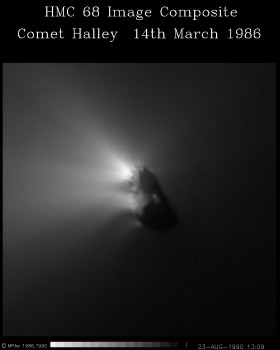
|
Science Highlight March 2006
|
 |

|
Science Highlight March 2006
|
 |
 20 years ago, on March 13 1986, the spacecraft Giotto encountered comet Halley. From the present point of view what were the most important results?
20 years ago, on March 13 1986, the spacecraft Giotto encountered comet Halley. From the present point of view what were the most important results?
Comet Halley is a relatively bright comet. When it is close to the Earth and Sun it usually can be observed with naked eye. It looks like a star with tail. From a star-like condensation a tail grows, which, if seen at a dark place without interfering street illumination, can reach a considerable length. 1705 Edmont Halley predicted the periodic return of this object which now bears his name. The comet moves around the Sun on an elongated ellipse with a period of 76 years. It reaches its closest distance to the Sun at 0.587 Sun-Earth distances (88 Million km) and its largest distance at 35 Sun-Earth distances (5.25 Billion km) outside of the orbit of Neptune. Comet Halley shone the Normans, when they defeated the British in the battle at Hastings. Giotto di Bondone painted comet Halley as Christmas star on top of his painting of the birth of Christ in the Scrovegni Chapel in Padua. Already before the encounter of the Giotto space probe with comet Halley it was known that the phenomenon of a comet comes from a nucleus of the size of several kilometers: According to Whipple the nucleus is a dirty snowball, consisting of water ice, mixed with other volatile (evaporable) substances and solid materials (dust). They evaporate (better sublime) when they are heated by solar irradiation and form the neutral coma and the plasma tail. The dust tail consists of the dust particles dragged along by the evaporating gases.
Why we are interested in comets today? In important question for man is the question about his origin. This includes the question about the origin of the Earth and the solar system. As we know now, our Sun formed from an interstellar molecular cloud. In the molecular clouds there are gas and small solid bodies (dust). If the molecular cloud exceeds a minimum density, e.g. by freezing out ice at extremely low temperatures, it contracts and a central star is formed. At the same time, because of the conservation of the angular momentum of the cloud, a proto-planetary disk is generated around the star from which planets form. In this process it is important that both components, gas and dust, are available. The young star heats up by contraction. Nuclear reactions ignite in its interior, the same ones that supply our sun with luminosity and energy today. Like the Sun today, the early sun was hot and heated the inner parts of its proto-planetary disk more strongly than the outer ones. This caused chemical differentiation: easily evaporable material was lost close to the Sun and entered the inner planets only to a minor extent. In the outer solar system, however, volatile constituents like hydrogen were implemented into the planets. There is one more differentiation, namely according to the mass (weight) of the forming body. Small bodies (diameter smaller than 100 km) remain more pristine than larger ones that are able to contract like the young sun because of their gravity and in course of this are heated again. In this process the primordial chemical constitution and the distribution of matter in the body is altered further. A surprisingly detailed information on the chemical and mineralogical constitution of the inner solar system (Mercury to Mars) is obtained from the study of meteorites that enter the atmosphere as luminous meteors (shooting stars) and finally can be collected from the ground as chunks of cosmic stones or metal. But what about the outer solar system?
Let us now return again to the Giotto space probe, as the investigations of this probe (and of the Russian VeGa probes) have played a crucial role in answering this question.
Needless to say that every new result creates further questions. In case of the cometary nuclei there is the question about their inner structure and about the physical mechanisms causing the evaporation of cometary matter from spatially limited active regions. Concerning the chemical constitution the measurements must become more accurate and more detailed. Appropriate experiments exist on the Rosetta space probe presently on its way to comet Churyumov-Gerasimenko. It would be best if we could at some time investigate a piece of a comet in the laboratory in the way we do it already a long time with meteorites. Cometary dust from comet Wild 2, embedded in so-called astrogel, was returned to Earth by the American Stardust space probe early this year. But until we will be able to analyze a chunk of cometary snow or ice in a terrestrial laboratory we must still wait a while.
| © 2009, Max Planck Institute for Solar System Research, Lindau |
Klaus Jockers 22-03-2006 |